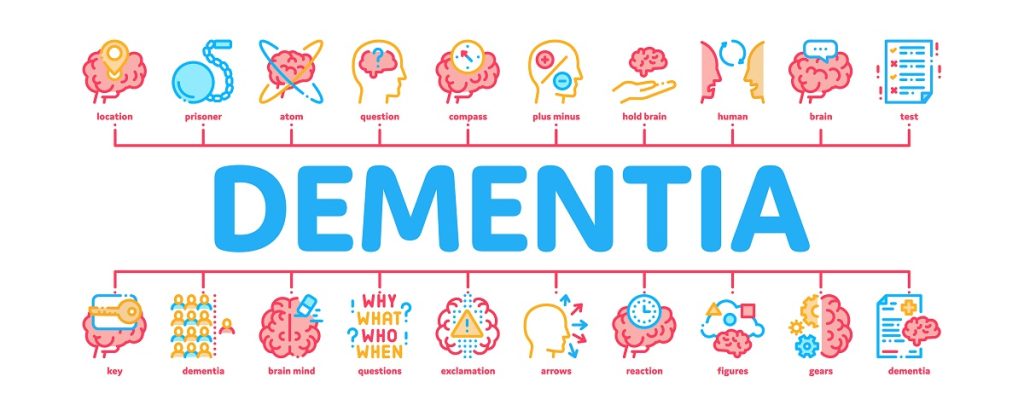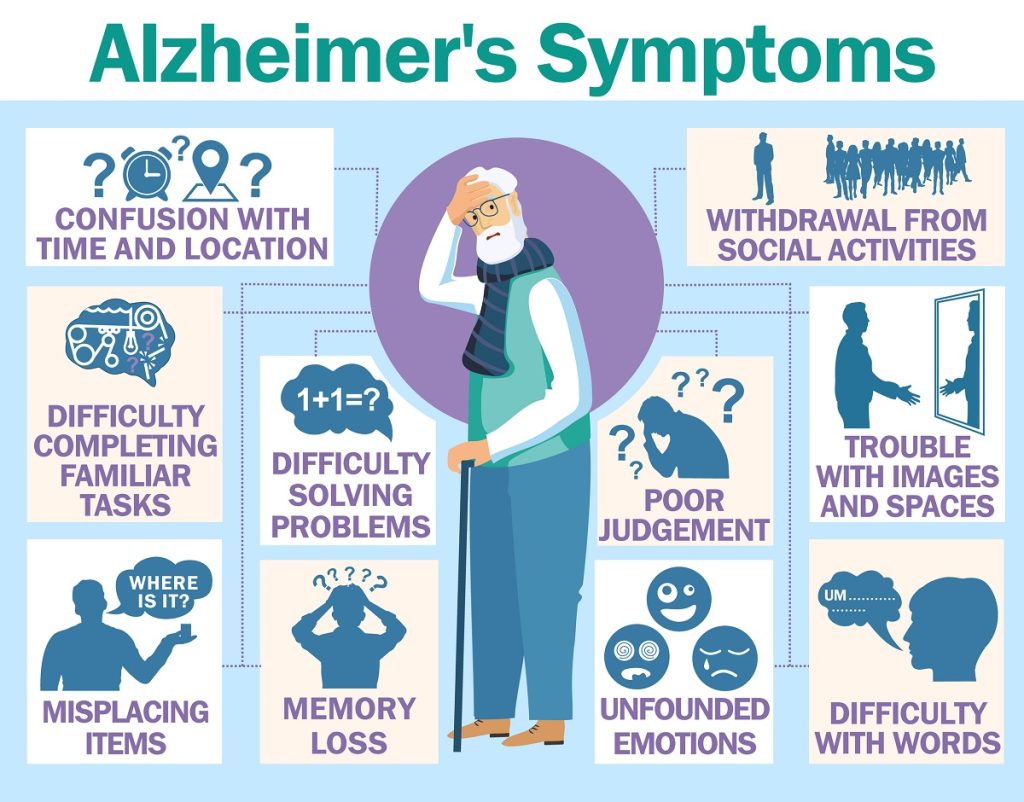Dementia is a general term that describes many neurological conditions that get progressively worse over time. It affects the ability to think, remember, and reason to levels that affect daily life and activities. Not everyone with these symptoms has dementia as at least 7 other conditions masquerade as dementia.
Recent estimates from the World Health Organization show that about 55 million people worldwide live with dementia. And every year, this figure increases by roughly 10 million. Learn about the different types of dementia, such as Alzheimer’s disease, and the conditions that can be mistaken for this syndrome.
What Is Dementia?
Dementia is a general term that describes several brain disorders affecting one’s cognitive function, including thinking, reasoning, problem-solving, and memory skills. It’s a syndrome severe enough to interfere with someone’s daily life.
When once-healthy brain cells die, it can cause dementia. While age is dementia’s biggest risk factor — meaning, it’s more common among older adults — it’s not considered part of the normal aging process.
People with mild cognitive impairment, or memory and cognitive ability loss in its early stages, have a substantially increased likelihood of having dementia.
Other risk factors include family history, poor heart condition, depression, lack of physical activity, traumatic brain injury, and race. Senior African Americans are twice as likely to live with dementia than whites; Hispanics are 1.5 times more likely.

The different brain diseases that fall under dementia include:
1. Alzheimer’s
With this disorder, changes in the brain impair one’s memory and thinking skills, which progressively worsen.
2. Vascular dementia
This second most common dementia is caused by damage to the brain’s blood vessels. It can also result from an interrupted blood and oxygen flow to the brain.
3. Frontotemporal dementia
Often called FTD, frontotemporal dementia results from damage to neurons in the frontal and temporal lobes of the brain. This disease is commonly linked to irregular forms or levels of the proteins TDP-43 and tau and is more prevalent among people below 60 years old, making it an uncommon type of dementia.
4. Dementia with Lewy Bodies
Lewy body dementia (LBD) results from abnormal amounts of the protein alpha-synuclein (lewy bodies) that cause problems with thinking, movement, behavior, and mood. A common form of dementia, it affects 1 million people usually over 50.
5. Parkinson’s Disease Dementia
This rare form of dementia is characterized by a decline in the cognitive function of patients diagnosed with Parkinson’s disease. Memory loss and dementia follow the physical symptoms. may follow a year or so after the onset of the disease.
6. Mixed Dementia
A dementia diagnosis wherein a patient has more than one type of dementia.
7. Dementia With Reversible Causes
In some cases of dementia, the underlying cause is still reversible. This includes medication side effects, hormonal imbalance, and vitamin deficiency.
It is challenging to diagnose dementia. Doctors need to review the patient’s medical history and study one’s loss of function and skills. Along the way, neurologists will use different cognitive tests, neurology evaluation techniques, laboratory tests, neuroimaging, and psychiatry.

What Are The Clinical Signs or Indicators Of Dementia?
Though there are various types of dementia, there are common signs and symptoms that caregivers and family members with an at-risk loved one should watch out for. These include:
- Bouts of forgetfulness or memory loss
- Problems with language and speech
- Difficulty doing routines (e.g., getting dressed, preparing a meal)
- Losing balance and experiencing mobility issues
- Poor judgment
- Time and place disorientation
- Loss of interest in daily activities and life events
- Changes in mood, behavior, and personality
People who exhibit any of these indicators should undergo a proper diagnosis of dementia. When diagnosing brain disorders, suspected individuals undergo several assessments of cognitive abilities such as problem-solving and memory.
What Conditions Can Be Mistaken For Dementia?
Some health conditions masquerade as brain disorders and exhibit dementia-like symptoms in older people. These include:
1. Nutritional Deficiencies
Lack of vitamins, particularly vitamin B12 deficiency, can lead to anemia and cognitive loss in geriatric patients. Studies show that vitamin B9 deficiency can also cause cognitive decline.
2. Hormonal Imbalances
Low or excessive levels of thyroid hormones can impair one’s thinking abilities. Other metabolic causes may also impair brain function. If treated promptly, such dysfunctions mimicking dementia can be reversed. If left untreated, such imbalances may cause permanent brain damage.
3. Medication Side Effects
Some drugs, like pain medications, can interfere with how a patient thinks or behaves. Hospitalization and anesthesia can cause older-aged patients to have delirium.
4. Urinary Tract Infection (UTI)
Apart from incontinence, UTI displays symptoms that can be mistaken for dementia — such as hallucination, withdrawal, poor concentration, or agitation. This is true for older people contrasted to younger people whose UTI will manifest as frequent urination, pain in the lower abdomen, fever, or low back pain.
5. Normal Pressure Hydrocephalus (NPH)
NPH is caused by excess fluid in the ventricles of the brain that does not cause increased pressure as measured via a spinal tap. One of the symptoms of NPH is having problems with memory and thinking, mimicking dementia.
6. Head Trauma
Head injury can cause subdural hematoma (bleeding inside the skull), which, in turn, can result in cognitive impairment.
7. Depression
Mental disorders like depression can cause fatigue, extreme mood swings, confusion, disorientation, and memory problems.

What Is The Most Common Form Of Dementia?
There are different forms of dementia. But according to the Alzheimer’s Association, Alzheimer’s disease is the most common — affecting 60 to 80% of the population with dementia.
In the US, over 6 million Americans suffer from this brain disorder. This number is projected to more than double by 2050. The risk is higher for women; about 2/3 of Alzheimer’s patients in America are women.
What Is The Difference Between Dementia And Alzheimer’s Disease?
Dementia is a syndrome and not a specific disease. Alzheimer’s, on the other hand, is a brain disease that falls under dementia. It is characterized by cognitive impairment, including the deterioration of one’s executive function or skills needed to perform complex goal-driven tasks.
Being the most common dementia diagnosis, the prevalence of this disorder has been significantly affecting the US healthcare system. In fact, more than 11 million American families and unpaid caregivers provide unpaid help to patients with Alzheimer’s or other types of dementia.
Alzheimer’s and other dementias will cost the US about $321 billion in 2022 alone. This figure can reach about $1 trillion in less than three decades.
While clinicians and care providers continue to diagnose and help patients manage their daily lives, researchers are yet to find a way to cure or at least slow the progression of the disease.
How To Identify 7 Conditions Masquerading As Dementia
Some treatable conditions and other brain disorders can be confused with Alzheimer’s, including the following:
- LATE. This stands for limbic-predominant age-related TDP-43 encephalopathy. It’s a recently reported brain disorder that shares symptoms like memory impairment with Alzheimer’s. This is more likely among the “oldest old” and advances more slowly than Alzheimer’s.
- Vascular dementia. Though this form of dementia also causes memory loss, it affects patients’ problem-solving and thinking abilities more. Additionally, this dementia is highly linked to stroke and other heart-related conditions. It is the second most common type of dementia.
- Brain tumor. When there’s a tumor in the brain, it can affect some of the patient’s cognitive function. Surgically removing the tumor may improve their condition.
- Vestibular disorders. These disorders (e.g., vertigo, labyrinthitis) affect the inner ear and brain, which help regulate one’s balance and some cognitive abilities.
- Diabetes. Diabetes disrupts how your body control insulin and blood sugar. Once your blood sugar level drops, it can affect how your brain and body function.
What Are The Best Ways To Prevent Dementia?
Until today, there’s no proven cure or prevention for Alzheimer’s disease and other forms of dementia. However, you can minimize the risk of having one by following these tips:

Eat Healthily
Add more vegetables and fruits to your diet, and opt for lean meat and seafood, whole grains, and unsaturated fats. This will help control sugar and high blood pressure and address vitamin and mineral deficits.
Avoid Smoking And Cut Down On Alcohol Consumption
Smoking and alcohol abuse can increase your risk of stroke, heart disease, and other medical conditions affecting brain function.
Be More Physically Active
Doing 150 minutes of moderate aerobic exercises (e.g., brisk walking, dancing, cycling) can minimize various risk factors for dementia. It can also help you control your metabolic processes and maintain your ideal weight.

Care For Your Mental Health
You can stay mentally active by doing brain exercises (e.g., reading, writing, learning new skills, and playing board games). Be more mindful and take breaks often — spend time for yourself and your loved ones. Also, be sure to get enough sleep because it benefits your mind and body.
Attend Regular Check-Ups And Screenings
Learning about any health concern early on will give you and your healthcare provider more time to manage/treat your condition and prevent it from worsening. If you or a loved one has symptoms of dementia, take the time to visit your doctor for a proper diagnosis.
Before determining that a senior with failing memory has dementia, it is important that the doctor check whether that is the problem or whether it is one of the 7 conditions masquerading as dementia.

